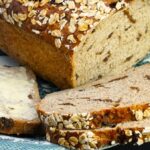
Cinnamon Raisin Oat Bread (no-knead, overnight recipe)
A lightly sweet, spicy and fruity bread that's delicious sliced and spread with butter for breakfast, at teatime or as a snack. Also good toasted to bring out the nuttiness of the oats and the warm spice flavour.
If you prefer a less sweet taste, you can leave out the honey.
Ingredients
- 1 tbsp honey
- 200 ml hot water from a kettle
- 125 g raisins
- 350 g white bread flour
- 150 g fine oatmeal (or rolled/porridge oats ground in a blender)
- 100 g wholemeal bread flour (can be replaced with more white bread flour)
- 3 tsp ground cinnamon (level or heaped tsp depending how strong a flavour you want)
- 2 level tsp instant dry yeast i.e. the kind that does not need activating in liquid before use
- 2 level tsp salt
- 160 - 180 ml milk
For the oat topping
- 1 egg white beaten with a splash of water
- rolled oats
Instructions
The day before baking
-
Dissolve the honey in the hot water and pour over the raisins. Stir then leave to soak until plumped up and the liquid is cold.
Over a jug to catch the soaking liquid: strain the raisins through a sieve then press with the back of a spoon to get more of the liquid out.
-
Pour enough milk into the reserved soaking liquid to make it up to 360 ml.
-
Put the flours, oatmeal, cinnamon, yeast, and salt in a large mixing bowl and stir together.
Stir in the raisins, ensuring each is coated in the dry mixture.
-
Make a well in the centre of the flour mixture then start pouring in the liquid, stirring with a silicone spoon to start bringing the ingredients together.
Add as much of the liquid as needed to form a wettish but not sloppy dough (see image in blog post for how it should look). Stir well so there are no dry bits of flour, adding an extra splash of water or milk if necessary.
-
Cover the dough and leave overnight or 12 - 14 hours.
Tip: If the room is warm, or if you'd like a longer rise for convenience or to allow more flavour to develop, you can put the dough in the fridge for up to 24 hours. Bring the dough back up to room temperature before proceeding with the recipe.
On the day of baking
-
Grease a 900 g/2 lb loaf tin with butter and lightly dust with flour.
-
The dough should have risen, spread out, and look a little bubbly. If not, leave longer.
Lightly flour a work surface and scrape the dough onto it.
Fold the dough over itself several times until it's smooth, at the same time shaping it to fit the length and breadth of the loaf tin: try not to add much more flour but only just enough to prevent sticking to the work surface.
Put the dough in the prepared tin and place in a large polythene bag or cover with cling film or a wet tea towel. Set aside somewhere warm for 30 - 45 minutes or until almost doubled in size.
While the dough is proving: preheat the oven to 180°C / 160° Fan / Gas 4 / 350°F with a shelf in the middle and a deep roasting tray on the bottom shelf (this will be filled with cold water later to create steam and help the bread rise).
-
Check that the dough is proofed:
If, when a finger is gently poked into the dough, the dough slowly springs back but leaves a slight indentation then it is ready to bake.
If the dough springs back quickly then it's not yet fully proofed: leave another 5 -10 minutes and check again.
-
When ready to bake, add the oat topping:
Brush a layer of the beaten egg white and water over the top of the dough.
With a sharp knife or baker's lame, make a slash all along the length of the top. Sprinkle over the rolled oats (try not to let them fall into the slash), very gently press down to help them stick, then brush over another layer of egg white.
-
Place the tin in the oven then pour cold water from a jug into the hot roasting tray in the lower part of the oven. Immediately close the door.
Bake for 30 minutes.
After 30 minutes carefully open the oven door (caution: lots of hot steam may billow out so keep your face, hands etc. out of the way) and remove the tray of water.
Take the loaf out of its tin and place back in the oven directly on the middle shelf. Cook for another 6 - 10 minutes or until the bottom of the loaf sounds hollow when tapped.
-
Place on a wire rack until completely cold before slicing.
Best eaten within 2-3 days or can be frozen. Also good toasted.
Tip: slice before freezing so you can take out just as much as you need without wastage.